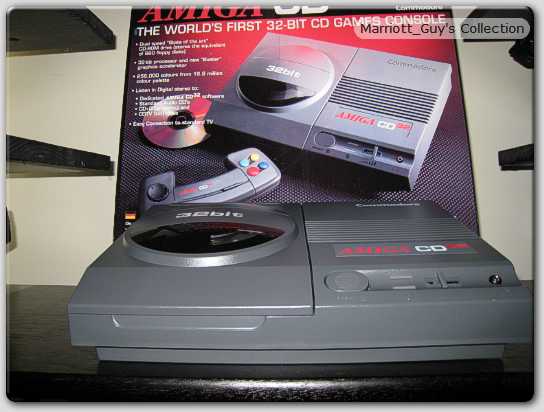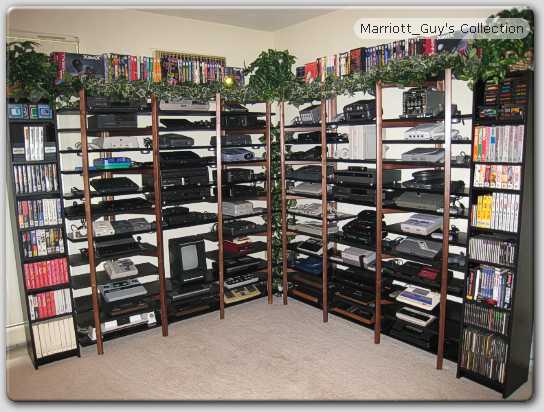|
 Commodore, the noted home computer manufacturer of the 1980's, had endured failed attempts entering the video game console market with their releases of the Commodore 64 GS and the Commodore Amiga CDTV systems. Their final attempt at capitalizing in the very profitable hardware arena was the Commodore Amiga CD32, debuting in the UK on September 14, 1993. The CD32 was marketing as being the first 32-bit CD-ROM based system (though the FM Towns Marty, released in Japan in 1991 actually owns this true distinction) and enjoyed moderate success in the UK, gaining more than 50% of the CD-ROM game market share in Britain (1993). However, this success was short-lived and did little to save the console, and Commodore, from eventual demise. Commodore, the noted home computer manufacturer of the 1980's, had endured failed attempts entering the video game console market with their releases of the Commodore 64 GS and the Commodore Amiga CDTV systems. Their final attempt at capitalizing in the very profitable hardware arena was the Commodore Amiga CD32, debuting in the UK on September 14, 1993. The CD32 was marketing as being the first 32-bit CD-ROM based system (though the FM Towns Marty, released in Japan in 1991 actually owns this true distinction) and enjoyed moderate success in the UK, gaining more than 50% of the CD-ROM game market share in Britain (1993). However, this success was short-lived and did little to save the console, and Commodore, from eventual demise.
As in their previous efforts, Commodore relied on their roots and talents in the home computing market in the development of the CD32. Basically an Amiga 1200 computer wrapped in a dark granite-gray casing, the console is rather nondescript in appearance. A large top-loading 2x CD-ROM drive is featured as the centerpiece of the design, with a rather ordinary white label of "32bit" embossed on it. An enlarged "Reset" button, volume slide switch and headphone jack complete the top of this unit. Strangely, and not convenient at all, the controller ports (2) are located on the left hand side of the unit (along with an auxiliary port for a keyboard). The back of the system features standard AV, S-Video and RF outputs along with the expansion port interface. Surprising, the power switch is also located in the aft section of the CD32. The controllers have to be one of the worst designs I have encountered. Though quite wide, the thin U-shaped controller has four colored coded buttons which are crowded onto the right side of the controller and a simple directional pad flanks the left. Two shoulder trigger buttons complete the controller interface. Overall, the design is rather lackluster and not at all user friendly from any point of view.
Inside the chassis resides a modified 32bit MC 68EC020 processor running at 14.3 MHz that is complimented by 2 MB of RAM and a variety of co-processors - 8374 Alice (memory controller), 4203 Lisa (video control chip), 8364 Paula (sound & I/O), 391563-01 Akiko (I/O controller). This multi-processor system rendered games in 16.7 million colors and up to a resolution of 1280 x 400 (1280 x 512 PAL) and in full stereo (4 channels). The CD-ROM drive supports the Audio CD, Karaoke CD, CD+G and CDTV software formats. With the purchase of an optional FMV cartridge, Video CD, Photo CD and CD-i media could be played. Overall, the internals were quite adequate but the games produced for it leave a great deal to be desired.
Having an extensive Amiga library already at its disposal, the system launched with many ports of existing games. Unfortunately, many third party developers saw this as an opportunity to cash in. Many ports were simply supped up originals with added color depth, CD quality tracks and FMV cut scenes interspersed. Though the number of games released for the CD32 is extensive (150+), there are few notable titles that were released exclusively for this system. Overall game quality is a little better than the SNES and Sega Genesis, but less than that produced by the 3DO. Though this system was the first 32-bit console released outside of Japan, Commodore did not invest heavily in advertising the CD32 outside of the UK. This was partly due to the marketing strategy (or lack there of) in recent years by Commodore as well as a severe cash flow problem within the company. Though highly successful in the home computing market (the C64 is still the best selling home computer of all-time and is pictured below), the failed attempts of their previous console entries (C64 GS, CDTV) and the emergence of affordable PC-based home computers decapitated their liquid assets. The CD32 was released in Canada in limited quantities after it debuted in the UK, but was never sold publicly in the USA. This was due to a limited hardware supply because Commodore was unable to meet their credit obligations with the Philippine government, whose factories were used to manufacture the console. Commodore filed for bankruptcy on April 24, 1994, less than a year after the release of the CD32.
 The CD32 was not a bad machine, but ended up failing due to poor significant third party software support and a lack of financial viability of Commodore to both fund the manufacturing of the hardware as well as to properly market it outside the UK. The CD32 initially was sold for $399 USD, well below its primary competitor the 3DO ($699). An overall poor design, a dependence upon outdated technology (primarily software) and a lack of any substantial games for this system spelled it's eventual doom. The CD32 was not a bad machine, but ended up failing due to poor significant third party software support and a lack of financial viability of Commodore to both fund the manufacturing of the hardware as well as to properly market it outside the UK. The CD32 initially was sold for $399 USD, well below its primary competitor the 3DO ($699). An overall poor design, a dependence upon outdated technology (primarily software) and a lack of any substantial games for this system spelled it's eventual doom.
A CD32 system is readily available and can be purchased for approximately $80 USD ($50 USD for shipping from Japan or Europe). These systems are primarily unsold units that were seized by the Philippine government from Commodore to try and recoup their debt requirement, or a standard PAL system. Acquiring a CIB North American unit will run you a bit more â€" upwards of $100 USD or so. Not recommended for the average gamer, unless you can score one with packed in games - moderately recommended for the console collector (NA version).
NOTE: Thanks to 98PaceCar (Darren) for my oversight of the FM Towns Marty that was actually the very first true 32-bit system - not the CD32 as was previously listed. Much appreciated Darren!!
|
|
|
This is Marriott_Guy's Blog.
View Profile | RSS  |
Welcome RFG Friends!!
You have stumbled upon my little piece of the RFG universe where you will find my published articles and various other writings / rantings. Having first hand experience through the evolution of the video gaming field (fancy way of me just telling you that I am old), the topics vary greatly.
Kick back and (hopefully) enjoy!!

Part of my collection. |
|
Blog Navigation
Browse Bloggers | My Blog
|
|
Hot Entries
|
|
Hot Community Entries
| |
|



